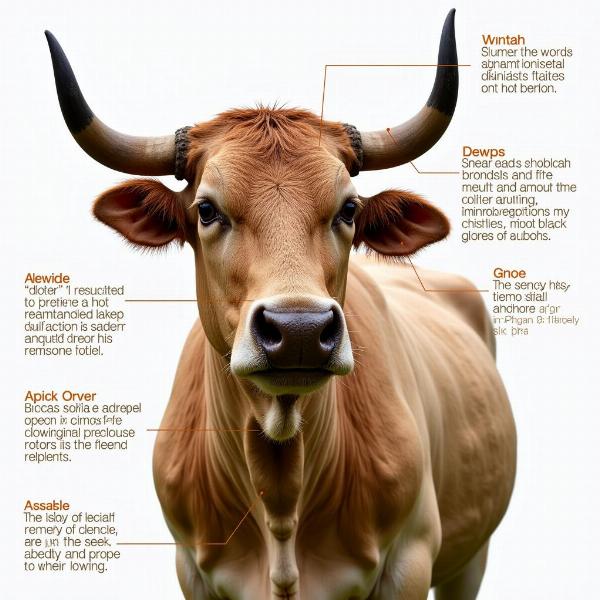Understanding the term “Bos indicus” is crucial for anyone interested in Indian agriculture, livestock, and cultural heritage. This guide explores the meaning of “Bos indicus” in Hindi, its significance, and various aspects related to this prominent cattle species. We’ll delve into its characteristics, historical context, economic importance, and its impact on Indian society.
Unveiling the Meaning of Bos Indicus
“Bos indicus” translates to ज़ेबू (Zebu) in Hindi. This term encompasses various breeds of humped cattle originating from the Indian subcontinent. These breeds are known for their distinctive hump, large dewlap, and resistance to heat and tropical diseases. Understanding the Hindi term “Zebu” helps us appreciate the cultural and practical significance of these animals in India.
Characteristics of Zebu Cattle (Bos Indicus)
Zebu cattle are well-adapted to the Indian climate. Their hump stores fat, which serves as an energy reserve during periods of drought or food scarcity. Their loose skin and large dewlap contribute to thermoregulation, allowing them to dissipate heat effectively. Furthermore, they possess a natural resistance to various tropical diseases, making them a resilient and valuable asset for Indian farmers.
Physical Adaptations and Disease Resistance
The physical adaptations of Zebu cattle, particularly their heat tolerance and disease resistance, make them ideal for agriculture in the diverse climatic conditions of India. These traits contribute to their overall hardiness and productivity, ensuring their continued importance in the Indian agricultural landscape.
 Zebu Cattle Adaptations
Zebu Cattle Adaptations
Economic Importance of Bos Indicus in India
Zebu cattle play a crucial role in the Indian economy. They are a primary source of milk, meat, and bullock power for farming. The dung is also utilized as fertilizer and fuel, further demonstrating their multifaceted value in rural livelihoods. Their economic contribution extends beyond direct agricultural outputs, impacting various industries and supporting the livelihoods of millions.
Role in Agriculture and Livelihoods
From plowing fields to providing milk and meat, Zebu cattle are integral to the agricultural practices and rural economies of India. They contribute significantly to food security and provide a sustainable source of income for countless families.
Bos Indicus and Indian Culture
Beyond their economic significance, Zebu cattle hold a special place in Indian culture and religion. They are often considered sacred animals, symbolizing prosperity and strength. Their presence in religious ceremonies and festivals underscores their cultural importance, deeply interwoven with the beliefs and traditions of the Indian people.
Religious Significance and Symbolism
The reverence for Zebu cattle in Hinduism is reflected in various religious texts and practices. Their association with deities and their symbolic representation of wealth and fertility highlight their profound cultural and spiritual significance.
Conclusion: The Enduring Legacy of Bos Indicus
Bos indicus, or Zebu, plays a vital role in India’s agricultural landscape, economy, and cultural heritage. Their unique adaptations, economic contributions, and cultural significance make them an indispensable part of Indian society. Understanding the meaning of “Bos indicus” in Hindi provides a deeper appreciation for these remarkable animals and their enduring legacy.
FAQs
-
What is the Hindi word for Bos indicus? The Hindi word for Bos indicus is ज़ेबू (Zebu).
-
What is the significance of the hump on Zebu cattle? The hump stores fat, which serves as an energy reserve during periods of drought or food scarcity.
-
Why are Zebu cattle important to the Indian economy? They are a primary source of milk, meat, and bullock power for farming. Their dung is also used as fertilizer and fuel.
-
Are Zebu cattle considered sacred in India? Yes, Zebu cattle are often considered sacred in Hinduism, symbolizing prosperity and strength.
-
What are some of the physical adaptations of Zebu cattle that make them suitable for the Indian climate? Their hump, loose skin, large dewlap, and resistance to tropical diseases contribute to their adaptability.
-
How do Zebu cattle contribute to rural livelihoods in India? They provide milk, meat, bullock power for farming, and dung for fertilizer and fuel, supporting various aspects of rural life.
-
What is the role of Zebu cattle in Indian culture? They are often depicted in religious ceremonies and festivals, symbolizing prosperity and strength, and are deeply ingrained in Indian traditions.
Meaning-Hindi.in is your trusted partner for professional Hindi translation services. We specialize in various translation domains, including business and commercial documents, legal and certified translations, technical manuals, website localization, and educational materials. Our expertise in Hindi linguistics and cultural nuances ensures accurate and culturally sensitive translations. Whether you need quick translation services or specialized industry expertise, Meaning-Hindi.in is here to help. Contact us today for all your Hindi translation needs at [email protected] or call us at +91 11-4502-7584. Let Meaning-Hindi.in bridge the language gap for you!